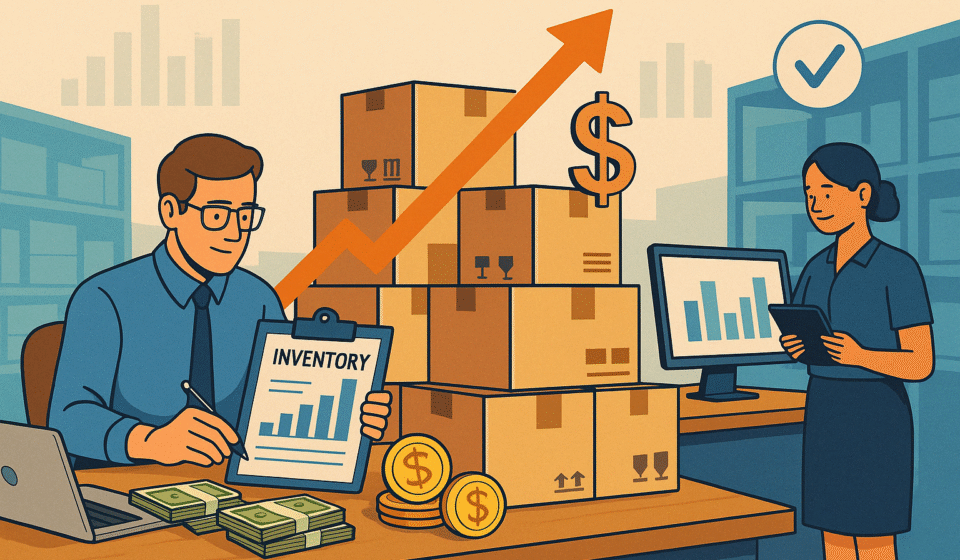
How AI Can Reduce Working Capital by Optimizing Inventory Levels
Unlocking Cash, Boosting Agility, and Driving Smarter Supply Chains
In today’s high-stakes business environment, cash is not just king — it’s oxygen.
Table Of Content
- Unlocking Cash, Boosting Agility, and Driving Smarter Supply Chains
- The Working Capital Trap: Why Inventory Bloats
- How AI Changes the Inventory Equation
- ✅ 1. Smarter Demand Forecasting
- ✅ 2. Dynamic Safety Stock Calculation
- ✅ 3. Network-Wide Optimization
- ✅ 4. Predictive Replenishment and Automation
- Quantifying the Impact: Real Financial Gains
- Why This Matters for CFOs, COOs, and Supply Chain Leaders
- Getting Started: How to Deploy AI for Inventory Optimization
- Conclusion: Inventory Should Work for You, Not Against You
Yet, across industries, one of the largest consumers of cash remains inventory sitting idle in warehouses. Excess stock ties up working capital that could otherwise be fueling growth, innovation, or operational resilience. On the other hand, cutting too deep risks stockouts, lost sales, and unhappy customers.
Finding the right balance between service levels and inventory investment has always been challenging. But today, AI is rewriting the playbook — offering a smarter, data-driven way to optimize inventory while unlocking significant working capital.
The Working Capital Trap: Why Inventory Bloats
Traditional inventory planning relies on historical averages, simple safety stock calculations, and manual forecasting methods. These approaches often lead to:
- Overbuffering “just in case” stock
- Inaccurate demand forecasts
- Fragmented planning across business units
- Limited visibility into supplier performance or lead time variability
The result? Millions (sometimes billions) in cash trapped on shelves, creating drag on balance sheets without necessarily improving customer service.
How AI Changes the Inventory Equation
AI-powered inventory optimization doesn’t just improve forecasts — it fundamentally reshapes how decisions are made by factoring in far more complexity than humans can process alone.
✅ 1. Smarter Demand Forecasting
AI models analyze patterns across:
- Seasonality and trends
- Promotions, holidays, and events
- Regional demand fluctuations
- External data (e.g., weather, market shifts)
Result: More accurate predictions of what will actually sell, allowing inventory levels to match real-world demand instead of assumptions.
✅ 2. Dynamic Safety Stock Calculation
Instead of one-size-fits-all safety stock buffers, AI continuously adjusts safety stock based on:
- Demand variability
- Lead time reliability
- Supplier performance
- Service level targets
This means right-sizing buffers where needed, not everywhere — freeing up unnecessary cash tied up in excess stock.
✅ 3. Network-Wide Optimization
AI looks across the entire supply chain network — not just individual nodes — to optimize:
- Where inventory should be positioned
- How much to hold at each location
- How to balance transfers between sites
This reduces duplication of inventory across warehouses and enables strategic pooling of stock closer to where demand occurs.
✅ 4. Predictive Replenishment and Automation
AI can automate reorder decisions, triggering replenishment before stockouts occur but without over-ordering.
It adapts to:
- Supplier lead times
- Transit delays
- Demand spikes or slowdowns
The result is less guesswork, faster decisions, and leaner inventory.
Quantifying the Impact: Real Financial Gains
Studies show that 5–15% reductions in inventory levels are possible with AI-powered optimization — without sacrificing service levels. For a company with $100 million in inventory, that’s $5–15 million in working capital unlocked.
💡 Bonus Impact:
- Lower warehousing costs
- Reduced write-offs from obsolescence
- Improved cash flow and liquidity ratios
- Better alignment with ESG goals by minimizing waste
Why This Matters for CFOs, COOs, and Supply Chain Leaders
For CFOs: Freeing up working capital can reduce the need for borrowing, improve cash flow, and create flexibility for investment in growth initiatives.
For COOs and supply chain teams: Inventory becomes an enabler of agility, not a drag on performance.
For investors and boards: Smarter inventory management signals operational discipline and resilience — key factors in long-term value creation.
Getting Started: How to Deploy AI for Inventory Optimization
- Start with clean, connected data — demand history, lead times, supplier data, inventory positions.
- Identify high-value SKUs or segments where overstock or stockouts hurt most.
- Deploy AI-powered forecasting and optimization models on these segments.
- Pilot, measure, scale — track working capital improvement alongside service level performance.
- Integrate insights into daily planning and replenishment workflows — automate where possible.
Conclusion: Inventory Should Work for You, Not Against You
Inventory is often seen as a cost center. But with AI-powered optimization, it can become a strategic lever — reducing working capital, improving agility, and strengthening resilience.
By shifting from static plans to dynamic, data-driven decisions, supply chain leaders can unlock the hidden cash trapped in their networks — fueling growth and future-proofing their operations.






